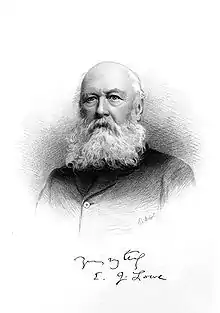Edward Joseph Lowe
Edward Joseph Lowe FRS FGS FRAS FLS (11 November 1825 – 10 March 1900) was a renowned English botanist, meteorologist and astronomer, who published papers on a wide variety of subjects, including luminous meteors, sunspots, the zodiacal light, meteorological observations during the eclipse of 1860 (at Fuente del Mar, near Santander), conchology, ferns, grasses and other plants.[1][2]

Lowe was affectionately known as "The Big Snowflake" because of his beard.[3]
Biography

Lowe was born in Highfield House, University Park, Nottinghamshire, into a wealthy family. The son of Alfred J. Lowe, he began his scientific observations at the age of 15.[4] Alfred was a member of many national and local astronomical societies and was particularly interested in meteorology and astronomy.[5]
His interest in ferns led to his studying them. His most noted work was Ferns: British and Exotic and consisted of eight illustrated volumes published in London by Groombridge and Sons in 1856. The bookplates of which were drawn by A. F. Lydon[6] and engraved by Benjamin Fawcett. He collaborated on observations of luminous meteors with Professor Baden Powell of Oxford. Lowe invented the dry powder test for ozone in the atmosphere. He was one of the founders and original Fellows of the Meteorological Society and a Fellow of the Royal, the Geological, the Linnean, the Royal Astronomical and other learned Societies.
His candidature citation for the Royal Society read: The Author of "A Treatise on Atmospheric Phenomena" "Prognostications of the weather or signs of atmospheric changes." "a paper on 278 thunderstorms" & the Conchology of Nottingham, & various Papers on zodiacal light, meteors, 'Solar spots, Lana & Freshwater shells &c published in the Transactions of the British Association, Royal Astronomical Society, Zoological Society- &c - The discoverer of a new method of propagating cuttings of plants by the application of collodium. Distinguished for his acquaintance with the sciences of Meteorology & Natural History. Eminent asa Meteorologist - Having Published works on that Science. - and being actively employed in the cultivation of it [7]
After the Great Exhibition of 1851, plans were launched for a public observatory in Nottingham. Henry Lawson offered his collection of astronomical telescopes, but the project failed through lack of government funding. Lawson persuaded Lowe to accept the instruments for an observatory at Broadgate House.[8] in Beeston, Nottinghamshire which opened in 1855, with a rotating cupola roof.[2] The Beeston Observatory was mainly for meteorological observations. As well as the usual meteorological instruments it included an Earthquake Pendulum, which ascended 33 ft to the top of the building. The pendulum rod was of deal wood and terminated in a loaded bulb of brass and lead of 2 lbs in weight with a steel point which acted upon a smooth surface of hard baked chalk. When the top of the building was distributed by the shock of an earthquake, the steel point would inscribe a result in the chalk. At the top of the house, he installed Electrometers with lighting wires conducted from trees around the building. These were fed to two gilded balls and cylinders for determining the negative and positive character of the electricity and the relative amount.[8]
Lowe's father, Alfred also built another observatory in Beeston behind some houses on Lilac Grove near Beeston railway station. This survived until it was demolished in 1965.
In 1882 he moved from Beeston to Shirenewton Hall, near Chepstow, Monmouthshire, where he died on 10 March 1900.[2]
As a botanist he is denoted by the author abbreviation E.J.Lowe when citing a botanical name.[9]
Bibliography
- A Treatise on Atmospheric Phaenomena. Longman, London 1846.
- Beautiful-Leaved Plants, being a Description of the Most Beautiful-Leaved Plants in Cultivation in this Country. Groombridge, London 1864
Gallery

 Fern
Fern
References
- "Edward Joseph Lowe". Monthly Notices of the Royal Astronomical Society. Royal Astronomical Society. 61 (4): 185–186. 1901. Bibcode:1901MNRAS..61R.185.. doi:10.1093/mnras/61.4.185a. Retrieved 2 November 2015. (Obituary.)
- Cox, Madeline (2004). "Edward J. Lowe and the Nottingham Observatories". The Antiquarian Astronomer. Society for the History of Astronomy. 1: 6–10. Bibcode:2004AntAs...1....6C. Retrieved 2 November 2015.
- "Picture the Past". Picture the Past. Retrieved 17 November 2015.
- Beeston: Then and Now by Robert Mellors, 1916.
- "The Beeston Astronomer and his Observatories | Nottingham Hidden History Team". Nottinghamhiddenhistoryteam.wordpress.com. 27 May 2014. Retrieved 17 November 2015.
- Desmond, Ray; Ellwood, Christine, eds. (1994). Dictionary of British and Irish botanists and horticulturalists : including plant collectors, flower painters and garden designers (Rev. and updated ed.). London: Taylor & Francis. ISBN 0850668433.
- "GB 117", The Royal Society, Item Ref No: EC/1867/12
- "The Lawson Instruments at Beeston Observatory". Nottinghamshire Guardian. England. 28 June 1855. Retrieved 24 April 2016 – via British Newspaper Archive.
- Brummitt, R. K.; C. E. Powell (1992). Authors of Plant Names. Royal Botanic Gardens, Kew. ISBN 1-84246-085-4.
External links
![]() Media related to Edward Joseph Lowe at Wikimedia Commons
Media related to Edward Joseph Lowe at Wikimedia Commons